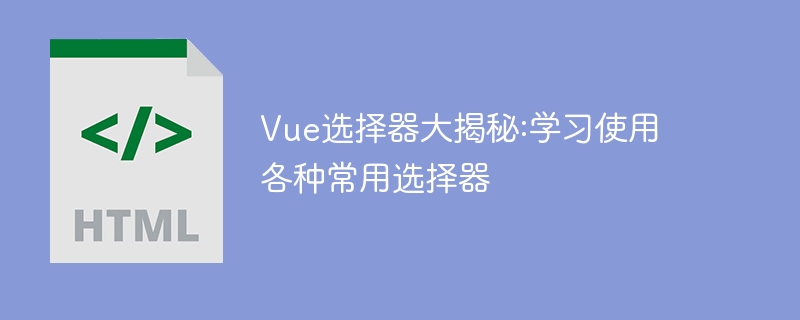Home >Web Front-end >HTML Tutorial >In-depth understanding of Vue selectors: Learn to use various common selector operations
In-depth understanding of Vue selectors: Learn to use various common selector operations
- 王林Original
- 2024-01-13 11:49:161215browse

Vue Selector Revealed: Learn to use various commonly used selectors
Introduction:
Vue, as a popular JavaScript framework, is widely used in front-end development. Vue selectors are an important concept during development, allowing us to select DOM elements and operate on them. This article will discuss Vue selectors in depth, introduce commonly used selectors, and provide sample code and usage tips. I hope that readers can better master the usage of Vue selectors through studying this article.
1. What is a Vue selector?
In Vue, a selector is a tool that allows us to select DOM elements and operate on them. Selectors are similar to CSS selectors, but have some specific syntax and functionality. Through selectors, we can select elements based on their tag names, class names, IDs, attributes, etc., and then operate the attributes, styles, content, etc. of these elements.
2. Commonly used Vue selectors
Tag selector: Select elements by their tag names, such as
<div>, <code><p></p>.Vue.component('my-component', { template: '<div>This is a div element</div>' })-
Class selector: Select elements by their class names, similar to CSS class selectors.
Vue.component('my-component', { template: '<div class="my-div">This is a div element with class</div>' }) -
ID selector: Select elements by their ID, similar to CSS's ID selector.
Vue.component('my-component', { template: '<div id="my-div">This is a div element with ID</div>' }) -
Attribute selector: Select elements through their attributes. You can select based on attribute names and attribute values.
Vue.component('my-component', { template: '<input type="text" name="my-input" value="example">' }) -
Descendant selector: Selects by the descendant elements of the element, separated by spaces.
Vue.component('my-component', { template: '<div><p>This is a paragraph inside a div</p></div>' }) -
Adjacent sibling selector: Select the next sibling element of an element, represented by the " " symbol.
Vue.component('my-component', { template: '<div></div><p>This is a paragraph</p>' }) -
Sibling selector: Select all sibling elements after an element, represented by the "~" symbol.
Vue.component('my-component', { template: '<div></div><p>This is a paragraph</p><div></div>' }) -
Multiple selectors: You can separate multiple selectors by commas and select multiple elements. .
Vue.component('my-component', { template: '<div class="my-div">This is a div element with class</div><p>This is a paragraph</p>' }) -
Selector attribute: You can use the attribute selector to select elements with specified attributes or attribute values.
Vue.component('my-component', { template: '<button data-step="1">Next</button>' }) -
Selector pseudo-class: You can use pseudo-class selectors to select elements that meet specific conditions.
Vue.component('my-component', { template: '<input type="text" name="my-input" :disabled="isDisabled">' }) -
Dynamic selector: You can select elements based on the value of a variable.
Vue.component('my-component', { template: '<div :class="{ 'my-div': isDiv }">This is a dynamic div element</div>' })
3. Tips for using Vue selectors
Conclusion:
Through this article’s explanation of Vue selectors, we have learned about commonly used selectors and usage techniques. Vue selectors play an important role in front-end development, allowing us to operate DOM elements more flexibly. I hope this article can help readers better understand the usage of Vue selectors, thereby improving the efficiency and quality of front-end development.
The above is the detailed content of In-depth understanding of Vue selectors: Learn to use various common selector operations. For more information, please follow other related articles on the PHP Chinese website!

